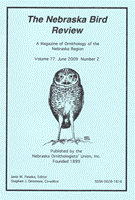Nebraska Ornithologists' Union

Nebraska Bird Review
Date of this Version
9-2017
Document Type
Article
Citation
The Nebraska Bird Review Vol. 85 No. 3 (2017), pp 94-120
Abstract
Changes in breeding ranges and numbers of Nebraska breeding birds are the primary focus of a Summer Seasonal Report. Every year there are changes to be noted; this year is no exception. Although most of the phenomena listed below are examples of dispersing individuals without breeding evidence, these often indicate breeding range expansion. White-winged Doves are becoming numerous in southern and western Nebraska, although breeding in far eastern Nebraska was only the 5th report for the state. Chuckwill’s- widow continues to creep westward in the south; the westernmost report to date was of one that crossed the 100-mile gap from Thayer Co to Harlan Co. Osprey continues to find success at as many as five existing locations in the west, but exciting was a successful new eastern site in Washington Co. New locations for nest-box breeding success for Northern Saw-whet Owl continue. Scissor-tailed Flycatcher added new counties to its range in the state: Red Willow and Jefferson. Sightings suggested that White-breasted Nuthatch continues to creep westward in riparian corridors. Continuing to move northward, Northern Mockingbird was reported at two northern locations. Carolina Wren, Tufted Titmouse, and Summer Tanager took significant jumps to the extreme northeast and to northeastern Cherry Co. Reports of Yellow-rumped (Audubon’s) Warbler in the Wildcat Hills of Scotts Bluff Co continue to increase, but breeding has not yet been documented there. Suggestive of adequate moisture conditions, Bobolink and Eastern Meadowlark both were found near Agate, normally an arid part of the state. Dickcissels, now taking pride in being last in the checklist order, were in high numbers statewide, notably in the far west. Rarities were led by a cooperative Brown Booby at Harlan County Reservoir for about a month; it was Nebraska’s second, and first available to birders. The fourth state record of a Black-chinned Hummingbird, and certainly not the last of this expanding-range species, was at Blair, Washington Co, for a few weeks, but not known to birders; the four records are scattered across the state. Other “quality” finds were the 22nd record of Neotropic Cormorant and 28th of Laughing Gull. Possibly as rare in terms of probabilities was a very late Tennessee Warbler, documented by recording and description. A word on Nebraska’s famous species pairs and their hybrid zones. There were several reports of the eastern or western species deep in the range of the other members of the species pair. While not unlikely, none of the reports mentioned the possibility of hybrids. I encourage observers to take care to examine plumages with care; hybrids are quite numerous within the hybrid zones. An example of the usefulness of describing plumages in understanding distributions is included in the Indigo Bunting account.
Included in
Ornithology Commons, Population Biology Commons, Poultry or Avian Science Commons, Zoology Commons


Comments
Published by the Nebraska Ornithologists’ Union, Inc.